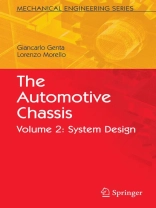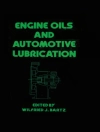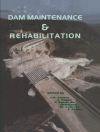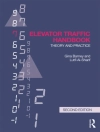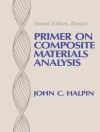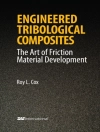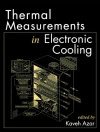This work serves as a reference concerning the automotive chassis, i.e. everything that is inside a vehicle except the engine and the body. It is the result of a decade of work mostly done by the FIAT group, who supplied material, together with other automotive companies, and sponsored the work. The first volume deals with the design of automotive components and the second volume treats the various aspects of the design of a vehicle as a system.
Innehållsförteckning
SYMBOLS LIST; III FUNCTIONS AND SPECIFICATIONS: INTRODUCTION TO PART THREE:
17 TRANSPORTATION STATISTICS: 17.1 Traffic volume; 17.2 Operating fleet; 17.3 Social impact;
18 VEHICLE FUNCTIONS: 18.1 Systemdesign; 18.2 Objective requirements; 18.3 Subjective requirements; 18.4 Aging resistance;
19 REGULATIONS: 19.1 Vehicle system; 19.2 Wheels 19.3 Steering system; 19.4 Braking system; 19.5 Structures; 19.6 Gearbox; IV THE CHASSIS AS A PART OF THE VEHICLE SYSTEM: INTRODUCTION TO PART FOUR:
20 GENERAL CHARACTERISTICS: 20.1 Symmetry considerations; 20.2 Reference frames; 20.3 Position of the center of mass; 20.4 Mass distribution among the various bodies; 20.5 Moments of inertia;
21 AN OVERVIEW ON MOTOR VEHICLE AERODYNAMICS: 21.1 Aerodynamic forces andmoments; 21.2 Aerodynamic field around a vehicle; 21.3 Aerodynamic drag; 21.4 Lift and pitching moment; 21.5 Side force and roll and yawmoments; 21.6 Experimental study of aerodynamic forces; 21.7 Numerical aerodynamics;
22 PRIME MOVERS FOR MOTOR VEHICLES: 22.1 Vehicular engines; 22.2 Internal combustion engines; 22.3 Electric vehicles; 22.4 Hybrid vehicles;
23 DRIVING DYNAMIC PERFORMANCE: 23.1 Load distribution on the ground; 23.2 Total resistance to motion; 23.3 Power needed for motion; 23.4 Available power at the wheels; 23.5 Maximum power that can be transferred to the road; 23.6 Maximum speed; 23.7 Gradeability and initial choice of the transmission ratios; 23.8 Fuel consumption at constant speed; 23.9 Vehicle take-off from rest; 23.10 Acceleration; 23.11 Fuel consumption in actual driving conditions;
24 BRAKING DYNAMIC PERFORMANCE: 24.1 Braking in ideal conditions; 24.2 Braking in actual conditions; 24.3 Braking power;
25 HANDLING PERFORMANCE: 25.1 Low-speed or kinematic steering; 25.2 Ideal steering; 25.3 High-speed cornering: simplified approach; 25.4 Definition of understeer and oversteer; 25.5 High-speed cornering; 25.6 Steady-state lateral behavior; 25.7 Neutral-steer point and static margin; 25.8 Response to external forces and moments; 25.9 Slip steering; 25.10 Influence of longitudinal forces on handling; 25.11 Transversal load shift; 25.12 Toe-in; 25.13 Effect of the elasto-kinematic behavior of suspensions and of the compliance of the chassis; 25.14 Stability of the vehicle; 25.15 Unstationary motion; 25.16 Vehicles with two steering axles (4WS); 25.17 Articulated vehicles; 25.18 Multibody articulated vehicles; 25.19 Limits of linearized models;
26 COMFORT PERFORMANCE: 26.1 Internal excitation; 26.2 Road excitation; 26.3 Effects of vibration on the human body; 26.4 Quarter-car models; 26.5 Heave and pitch motion; 26.6 Roll motion; 26.7 Effect of nonlinearities; 26.8 Concluding remarks on ride comfort;
27 CONTROL OF THE CHASSIS AND ‘BY WIRE’ SYSTEMS:27.1 Motor vehicle control; 27.2 Models for the vehicle-driver system; 27.3 Antilock (ABS) and antispin (ASR) systems; 27.4 Handling control; 27.5 Suspensions control; 27.6 By wire systems; V MATHEMATICAL MODELLING: INTRODUCTION TO PART FIVE: 28 MATHEMATICAL MODELS FOR THE VEHICLE: 28.1 Mathematical models for design; 28.2 Continuous and discretized models; 28.3 Analytical and numerical models;
29 MULTIBODY MODELLING: 29.1 Isolated vehicle; 29.2 Linearized model for the isolated vehicle; 29.3 Model with 10 degrees of freedom with locked controls; 29.4 Models of deformable vehicles; 29.5 Articulated vehicles; 29.6 Gyroscopic moments and other second order effects;
30 TRANSMISSION MODELS: 30.1 Coupling between comfort and drive line vibration; 30.2 Dynamic model of the engine 30.3 Drive line; 30.4 Inertia of the vehicle; 30.5 Linearized drive line model; 30.6 Non-time-invariant models; 30.7 Multibody drive line models;
31 MODELS FOR TILTING BODY VEHICLES: 31.1 Suspensions for high roll angles; 31.2 Linearized rigid body model; 31.3 Dynamic tilting control; 31.4 Handling-comfort coupling; BIBLIOGRAPHY OF VOLUME 2:
A EQUATIONS OF
